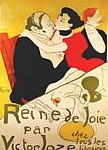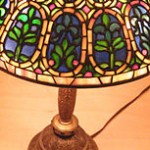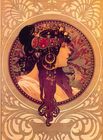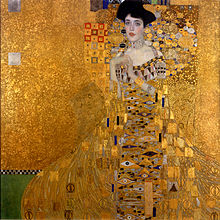
The artistic movement, Art Nouveau, was given a name when the American connoisseur, Samuel Bing opened his shop in Paris in 1895. He named the shop “La Maison de l’Art Nouveau.
By 1900 the new esthetic was evident in the works of Post-Impressionist painters such as Paul Gauguin and Paul Signac, and was especially noticeable in the art of Toulouse-Lautrec.

In Austria the Jugendstil (youth style) was espoused by the Secessionist movement of young artists and designers. Gustav Klimt was one of its most prominent figures. However, the person who most represented Art Nouveau was Czech artist, Alphonse Mucha, designer of posters for Sarah Bernhardt.

The movement swept across Europe and as a style extended beyond fine arts. Almost all aspects of material culture, from riding boots to ashtrays, postage stamp to furniture were redesigned in the “art nouveau” style, with characteristic swirling fabrics, wind blown plants and trailing tendrils. In New York, Louis Comfort Tiffany produced lampshades dripping fruit illuminated from within. The movement even inspired architecture. The Spaniard, Antonio Gaudi, designed buildings in a very personal style.
Art Nouveau embraces all the elements of design. It was international, genuinely popular and not restricted to an artistic elite.



